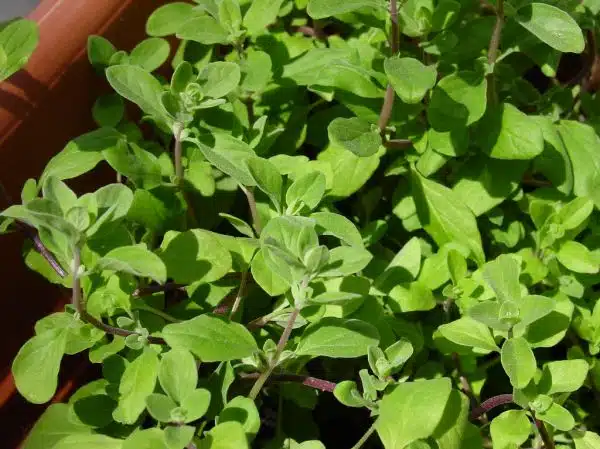Marjoram is an aromatic herb that belongs to the mint family. It is a popular culinary herb that adds a sweet and spicy flavor to various dishes, including pasta sauces, soups, stews, and meat dishes. Marjoram is easy to grow and maintain, making it an excellent addition to any home garden or kitchen.
In this article, we will explore how to grow marjoram successfully. We will discuss the best growing conditions for marjoram, including soil type, temperature range, watering frequency, and sunlight exposure. Additionally, we will outline the steps involved in planting marjoram from seed or cuttings and offer tips on caring for mature plants. Whether you are an experienced gardener or a beginner looking to grow your own herbs at home, this article will provide you with all the information you need to cultivate healthy and flavorful marjoram plants.
What Is Marjoram?
Imagine having a hearty Italian meal with a fragrant aroma that fills the air. The taste of the dish is savory, but there’s something else that makes it unique- marjoram. Marjoram is an herb belonging to the mint family. It is native to the Mediterranean region and is widely used in European cuisine.
In cooking, marjoram has aromatic and flavorful qualities that make it an indispensable ingredient in many dishes. Its mild and sweet flavor profile complements meat, poultry, vegetables, and stews. Some popular dishes that use marjoram include roasted chicken, soups, sauces, stuffing, and sausages. Besides its culinary uses, marjoram has medicinal properties too.
The medicinal properties of marjoram have been known for centuries. In traditional medicine, marjoram was used as a remedy for digestive issues like bloating and gas. It was also believed to relieve colds and coughs due to its expectorant properties. The essential oil extracted from marjoram has antiseptic properties that help in treating skin infections like acne and eczema. Overall, marjoram offers a range of benefits both for cooking and medicinal purposes.
Growing marjoram at home can be an excellent way to have fresh herbs at your disposal all year round. In the next section, we will discuss some benefits of growing marjoram at home and how you can get started with this herb gardening project without complications or difficulties.
Benefits Of Growing Marjoram At Home
- Marjoram is a fragrant and flavorful herb that can be grown easily in a home garden.
- The volatile oils in marjoram contain many beneficial compounds, including carvacrol and thymol, which have antimicrobial properties and offer a range of health benefits.
- The aromatic fragrance of marjoram can enhance the flavor of many dishes and can also be used to make herbal teas and infusions.
- Growing marjoram can be done in a variety of ways, from container growing to planting in the ground.
- Marjoram is a hardy herb that is resistant to most pests and diseases, making it an ideal choice for home gardeners.
- With the right conditions, marjoram can be harvested throughout the growing season, providing gardeners with a continuous supply of this fragrant herb.
Health Benefits
Marjoram is a wonderful herb that can be grown at home, and its health benefits are undeniable. This herb has been used for centuries to enhance the flavor of various culinary dishes, but it also boasts several health benefits. For instance, marjoram has been found to possess anti-inflammatory properties that can help reduce inflammation in the body. Similarly, this herb is known to contain antioxidants that can help fight off harmful free radicals.
Moreover, marjoram is also believed to have antimicrobial properties that can help prevent the growth of harmful bacteria in the body. This makes it an excellent herb to use when cooking meat or poultry, as it can help prevent food-borne illnesses. Additionally, marjoram may also be helpful in reducing muscle spasms and cramps due to its ability to relax muscles.
In conclusion, growing marjoram at home offers many benefits beyond just its culinary uses. Its health benefits make it a valuable addition to any diet or wellness routine. As a horticulturalist or gardening expert, I highly recommend growing this herb at home for both its delicious flavor and numerous health benefits.
Aromatic Fragrance
Aside from its culinary uses and health benefits, growing marjoram at home can also provide aromatherapy benefits. The aromatic fragrance of this herb is known to have a calming effect on the mind and body, making it an excellent addition to any relaxation routine. Moreover, the essential oil extraction from marjoram has been used in various traditional medicine practices for centuries due to its therapeutic properties.
The essential oil extracted from marjoram is believed to have several benefits, including reducing anxiety and stress levels. Its anti-inflammatory properties can also help alleviate pain and discomfort caused by sore muscles or joints. Additionally, using marjoram essential oil in aromatherapy sessions may help improve respiratory function and boost overall immune system health.
In conclusion, growing marjoram at home not only provides numerous culinary uses and health benefits but also offers aromatherapy benefits through its aromatic fragrance and essential oil extraction. As a horticulturalist or gardening expert, incorporating this herb into your garden can provide a holistic approach to wellness that can benefit both the mind and body.
Easy To Grow
Transitioning to the subtopic of ‘Easy to Grow,’ it is worth noting that marjoram is an herb that can be grown with ease, making it an excellent addition to any garden for beginners and experienced gardeners alike. Container gardening is a popular choice for growing marjoram as it allows for easy portability and management of the plant’s growth. Moreover, companion planting marjoram with other herbs such as basil or thyme can enhance its flavor and promote healthy growth.
When growing marjoram at home, one must consider the ideal growing conditions for this herb. Marjoram thrives in well-draining soil with full sun exposure but can also tolerate partial shade. It requires moderate watering and regular pruning to maintain its compact shape and prevent leggy growth. With proper care, marjoram can grow up to two feet tall and produce aromatic leaves that can be harvested throughout the growing season.
Overall, the benefits of growing marjoram at home extend beyond its culinary uses and health benefits. Its ease of growth makes it a viable option for beginners in container gardening or those looking to expand their herb garden. Furthermore, incorporating marjoram in companion planting practices can enhance the flavor of other herbs while promoting healthy growth.
Choosing The Right Location For Marjoram
One of the essential factors to consider when growing marjoram is choosing the right location. The plant thrives best in areas with full sunlight and well-drained soil. Therefore, it is crucial to select an area that receives at least six hours of direct sunlight each day. If you plan to grow marjoram indoors, ensure that you place it near a south-facing window or under grow lights to provide sufficient light.
On the other hand, if you opt to grow your marjoram outdoors, ensure that you choose a spot with well-draining soil. Marjoram does not tolerate wet feet; therefore, avoid planting it in areas prone to waterlogging. Additionally, avoid planting it in shaded areas as they hinder its growth and reduce its flavor potency. In summary, whether growing marjoram indoors or outdoors, ensure that it receives adequate sunlight and drainage.
In conclusion, selecting the right location for your marjoram plants is critical in ensuring a bountiful harvest. The plant requires plenty of sunlight and well-draining soil for optimal growth and flavor production. Therefore, take time to evaluate potential locations before planting your marjoram plants either indoors or outdoors. Next step: let’s dive into the ideal soil requirements for growing marjoram!
Soil Requirements For Growing Marjoram
Growing marjoram requires proper soil preparation to ensure its optimal growth and yield. The right type of soil, with the correct pH level, is crucial in creating an ideal environment for this herb to thrive. One common mistake in preparing marjoram soil is not adding enough organic matter, which can result in poor drainage and reduced nutrient availability.
To create the best compost for marjoram soil, start by mixing equal parts of perlite, peat moss, and vermiculite. This combination will ensure good drainage while also retaining moisture and nutrients essential for healthy marjoram growth. Additionally, add a small amount of well-aged manure or compost to provide extra nutrients for the plants.
The pH level for marjoram soil should be between 6.5 and 7.0. If the pH is too low or too high, it can affect nutrient availability and cause stunted growth or even death of the plant. Use a soil test kit to determine the pH level of your garden bed before planting marjoram. If necessary, adjust the pH level by adding lime (to raise pH) or sulfur (to lower pH). With proper soil preparation, you can ensure that your marjoram plants have everything they need to grow strong and healthy.
Moving forward into sunlight needs for marjoram plants, it’s important to note that light requirements are just as important as soil requirements when it comes to successful growth.
Sunlight Needs For Marjoram Plants
In order to grow marjoram successfully, it is important to understand the amount of sunlight needed. Marjoram is a plant that prefers a lot of direct sunlight and should get at least 6-8 hours of direct sunlight each day. Ideal sunlight conditions for marjoram is a sunny spot with some protection from strong afternoon sunlight, as this can be too intense and cause scorching of the leaves. When growing marjoram indoors, place the plant near a south or east-facing window with a sheer curtain to provide necessary sunlight.
Amount Of Sunlight Needed
Marjoram is a versatile herb that can be grown both indoors and outdoors. When it comes to sunlight needs, marjoram requires a substantial amount of exposure to the sun. The plant thrives in bright and direct sunlight, making it an ideal candidate for outdoor cultivation.
Indoor cultivation of marjoram requires careful consideration of the amount of sunlight the plant receives. While marjoram can grow indoors with artificial light sources, it is still important to ensure that the plant is exposed to a significant amount of natural light as well. A south-facing window that receives ample amounts of sunlight throughout the day is an excellent location for indoor marjoram plants.
Outdoor cultivation of marjoram requires even more attention to sunlight needs. The herb should be planted in a location that receives at least six hours of direct sunlight each day. Marjoram does best in areas with full sun exposure, as partial shade may hinder its growth and development. With proper care and attention to its sunlight needs, marjoram can flourish both indoors and outdoors, providing fresh herbs year-round for cooking and medicinal purposes.
Ideal Sunlight Conditions
Sunlight is an essential element in the growth and development of plants. Marjoram, a popular herb used for cooking and medicinal purposes, is no exception to this rule. Proper sunlight conditions are vital in ensuring that marjoram thrives both indoors and outdoors. In this article, we will discuss the ideal sunlight conditions required for growing healthy marjoram plants.
When it comes to sunlight needs, marjoram requires a substantial amount of exposure to the sun. The plant thrives in bright and direct sunlight, making it an ideal candidate for outdoor cultivation. If you intend to grow marjoram indoors, it is still important to ensure that the plant receives ample amounts of natural light in addition to artificial light sources. A south-facing window that receives ample amounts of sunlight throughout the day is an excellent location for indoor marjoram plants.
Outdoor cultivation of marjoram requires even more attention to sunlight needs. The herb should be planted in a location that receives at least six hours of direct sunlight each day. Marjoram does best in areas with full sun exposure as partial shade may hinder its growth and development. With proper care and attention to its sunlight needs, marjoram can flourish both indoors and outdoors, providing fresh herbs year-round for cooking and medicinal purposes.
Watering Marjoram Plants
Now that we have established the sunlight needs for marjoram plants, let’s move on to another important aspect of growing this herb – watering. Did you know that overwatering is one of the leading causes of death in marjoram plants? This is because marjoram prefers a well-drained soil and can easily develop root rot if left sitting in waterlogged soil for too long.
To ensure healthy growth, it is essential to monitor the moisture levels in your marjoram’s soil regularly. The frequency of watering will depend on various factors such as humidity levels, temperature, and pot size. As a general rule of thumb, it is best to wait until the top inch of soil feels dry to the touch before watering again. Over time, you will develop an intuition for when your plant needs water based on these visual cues.
Here are some tips to keep in mind when it comes to watering your marjoram plants:
- Water deeply but infrequently – this will encourage deeper root growth.
- Use room temperature water as cold water can shock the plant’s roots.
- Avoid getting water on the leaves as this can lead to fungal diseases.
- Consider using a self-watering pot if you are worried about forgetting to water your plant.
- If you notice yellowing leaves or wilting despite adequate moisture levels, it may be a sign that your plant is not getting enough light.
Moving forward, maintaining proper nutrition through fertilization is crucial for growing healthy and flavorful marjoram plants.
Fertilizing Marjoram Plants
Marjoram plants require proper nutrition to grow healthy and produce an abundant harvest. Fertilizing these plants is essential to ensure a bountiful yield. While marjoram is not a heavy feeder, it still requires some nutrients to thrive. Organic fertilizers such as compost or manure are excellent choices for providing the necessary nutrients without harming the environment.
Organic fertilizers are derived from natural sources and provide nutrients slowly over time. They also improve soil structure, increase soil fertility, and promote beneficial microbial activity in the soil. Compost and manure are rich in essential macronutrients such as nitrogen, phosphorus, and potassium, which support overall plant health. These organic fertilizers can be applied in early spring before planting or during the growing season at regular intervals.
Synthetic fertilizers can also be used to provide nutrients to marjoram plants; however, they have some drawbacks compared to organic options. Synthetic fertilizers can release high amounts of nutrients too quickly, leading to nutrient imbalances that may damage the plants’ roots or cause leaf burn. Additionally, synthetic fertilizers can harm beneficial microorganisms present in the soil that support plant growth. It’s best to use synthetic fertilizers sparingly and follow instructions on how much and when to apply.
To summarize, both organic and synthetic fertilizers are suitable for marjoram plants; however, organic options have more advantages than synthetic ones. Organic fertilizers slowly release essential nutrients while improving soil quality over time without harming the environment. Synthetic fertilizers should be used carefully because they can harm beneficial microorganisms present in the soil if not applied correctly.
Moving forward into propagating marjoram from seed…
Propagating Marjoram From Seed
After fertilizing your marjoram plants, it’s time to think about propagating them. One way to do this is through seed propagation, but another option is through cutting propagation. This method involves taking cuttings from an existing plant and rooting them to create a new one.
Indoor propagation is the most successful method for propagating marjoram from cuttings. Take a cutting from the top of the plant, just above a node where leaves are growing, and remove any leaves from the bottom 2 inches. Dip the cutting in rooting hormone and place it in a small pot filled with damp potting soil. Cover the pot with plastic wrap or a clear plastic bag to create humidity and keep the soil moist until roots form.
If you prefer outdoor propagation, take cuttings in early summer when the plant is actively growing. Choose healthy stems that are not flowering and make a clean cut just below a node. Remove all but a few leaves at the top of each cutting and dip them in rooting hormone before planting them directly into well-draining soil. Keep the soil moist until roots have formed, which can take several weeks depending on weather conditions. With either indoor or outdoor propagation, once roots have formed and new growth appears, you can transplant your new marjoram plant into its permanent home.
Propagating Marjoram From Cuttings
Marjoram can be propagated from cuttings, which is a popular method for gardeners who want to grow new plants. To propagate marjoram from cuttings, you should choose healthy stems that are not too woody or brittle. The best time to take cuttings is in the morning when the plant has the most water.
Before propagating your marjoram cuttings, it is important to prepare them properly. First, remove any leaves from the lower part of the cutting and dip it into rooting hormone. This will help stimulate root growth and increase your chances of success. Next, place the cutting into a pot filled with moist soil and gently press down to ensure good contact between the cutting and soil.
To maximize your chances of success when propagating marjoram from cuttings, there are several key tips to keep in mind:
- Choose healthy stems that are not too woody or brittle.
- Use rooting hormone to stimulate root growth.
- Optimal cutting length is around 4-6 inches.
- Keep your cuttings in a warm but shaded area until they start developing new roots.
Once your marjoram cuttings have developed strong roots, it’s time to transplant them into larger pots or directly into your garden bed. This process can be tricky, so it’s important to handle the delicate plants carefully and avoid damaging their fragile roots. In the next section, we will explore how to successfully transplant marjoram seedlings into their final growing location without causing undue stress to the plants.
Transplanting Marjoram Seedlings
To transplant marjoram seedlings is to take a step towards a more fruitful and bountiful garden. The act of moving the young plants from their original containers into larger, more spacious pots or planters will not only promote healthier growth but also ensure that the herb will thrive in your outdoor space. However, it is important to note that this process requires attention to detail and some basic knowledge of best practices.
Common mistakes often made during the transplanting process include disturbing the roots too much, not providing adequate drainage for the new container, and not acclimating the seedlings to their new environment. To avoid these errors, it is crucial to handle the roots gently during transplantation and choose a container with proper drainage holes. Additionally, gradually introducing the young plants to their new surroundings by placing them outside in small increments can help them adjust.
Best practices for transplanting marjoram seedlings include using well-draining soil, placing them in a location with ample sunlight, and watering them thoroughly but not excessively. After transferring the seedlings into their new containers, make sure they receive enough water without drowning them. Furthermore, pruning is an essential aspect of maintaining healthy marjoram plants.
In preparation for pruning marjoram plants, one must be aware of when to prune as well as what tools are necessary for the job. In general, it is best to prune marjoram after it has flowered or when it starts getting leggy in order to encourage bushier growth. A sharp pair of scissors or pruning shears are essential tools for making precise cuts without harming other parts of the plant. With careful attention paid throughout each step of cultivation and maintenance, your marjoram will flourish into a valuable addition to any herb garden.
Pruning Marjoram Plants
After transplanting marjoram seedlings, it is important to maintain the plant’s growth through proper pruning techniques. Pruning not only helps control the size and shape of the plant but also encourages healthy new growth. It is advisable to prune marjoram plants regularly throughout the growing season to promote bushier and more compact growth.
The best time to prune marjoram plants is in early spring when new growth begins or after harvesting when the plant has finished flowering. Pruning at these times promotes fresh and healthy growth for the upcoming season. Marjoram can be pruned by removing any dead, damaged, or diseased stems with clean and sharp shears. Additionally, trimming back one-third of its height can help maintain a healthy and vigorous plant.
Pruning marjoram plants requires careful attention to detail as it is a delicate herb that can easily become stressed if improperly pruned. Regular pruning helps keep pests and diseases at bay while maintaining optimal health for your plant. In the next section, we will discuss how to deal with pests and diseases that may affect your marjoram plant’s growth.
Dealing With Pests And Diseases In Marjoram
Identifying Pests in Marjoram: Common pests that may infest marjoram include aphids, spider mites, and whiteflies.
Preventing Infestations: To prevent pests from infesting marjoram, use a preventative approach such as planting marjoram in well-draining soil, providing adequate spacing between plants, and ensuring plants are not overcrowded.
Treating Infestations: If an infestation does occur, the most effective treatment is to remove any affected plants and to apply insecticidal soap or neem oil to the remaining plants. Biological controls such as ladybugs or lacewings can also be used to help control pest populations.
Identifying Pests
As any gardener knows, identifying pests in your plants is crucial to maintaining their health and productivity. Marjoram is no exception. There are several common pests that can wreak havoc on your marjoram plants, including aphids, spider mites, and whiteflies.
Preventative measures are always the best defense against pests. One effective method is to keep a clean garden bed, removing any dead or diseased plant material promptly. Additionally, planting companion plants such as basil or garlic can help deter pests naturally. Regularly inspecting your marjoram plants for signs of infestation can catch problems early and prevent them from spreading.
If preventative measures fail and your marjoram plants become infested with pests, there are natural remedies that can help. For example, neem oil or insecticidal soap can be used to control aphids and spider mites. Yellow sticky traps can also be placed around the garden bed to catch whiteflies. It’s important to follow instructions carefully when using any kind of pest control product to avoid harming beneficial insects or causing damage to the marjoram plants themselves.
Remember that identifying pests in your marjoram plants is just one part of dealing with pests and diseases in your garden. By taking preventative measures and using natural remedies when necessary, you can keep your marjoram healthy and productive all season long. Happy gardening!
Preventing Infestations
Preventing infestations is crucial to maintaining the health and productivity of marjoram plants. There are several effective methods to keep pests at bay. One of the best ways is to maintain a clean garden bed by removing any dead or diseased plant material promptly. This can help minimize pest populations and prevent diseases from spreading.
Companion planting is another natural option for preventing infestations. Planting basil or garlic alongside marjoram can help deter pests naturally. Regularly inspecting marjoram plants for signs of infestation can also catch problems early and prevent them from spreading.
If preventative measures fail, there are natural remedies that can help control pests in marjoram plants, such as neem oil or insecticidal soap. However, chemical options should be used with caution, as they can harm beneficial insects and damage the marjoram plants themselves. It’s important to follow instructions carefully when using any kind of pest control product to avoid unwanted consequences.
By taking preventive measures and using natural remedies when necessary, gardeners can help ensure that their marjoram plants remain healthy and productive throughout the growing season. Remember that prevention is always better than cure when dealing with pests and diseases in the garden.
Treating Infestations
After taking all preventive measures, sometimes infestations still occur in marjoram plants. When this happens, gardeners should take immediate action to control and treat the pests. One natural remedy for treating infestations in marjoram is using a diluted solution of dish soap and water as an insecticidal spray. This homemade solution can suffocate soft-bodied insects like aphids, spider mites, and whiteflies.
Another natural remedy is using neem oil, which is derived from the seeds of the neem tree. Neem oil can be used as a foliar spray to control a wide range of pests, including mites, caterpillars, and thrips. It also has some fungicidal properties that can help prevent diseases in marjoram plants.
In addition to natural remedies, there are also several pest control products available on the market that can effectively treat infestations in marjoram plants. However, it’s important to read labels carefully and follow instructions closely when using these products. Overuse or misuse of chemical pesticides can harm beneficial insects and pollinators and damage the environment as well. Gardeners should always prioritize natural remedies before turning to chemical options.
Harvesting Marjoram Leaves
Harvesting marjoram leaves is like picking a bouquet of fragrant flowers. The leaves are delicate, yet sturdy and come in clusters. Picking them requires a gentle hand, just like arranging flowers. To evoke the same feeling, make sure to pick the leaves when they are young and tender, before the plant has flowered.
Once you have harvested your marjoram leaves, you can use them fresh or dry them for later use. Drying methods include air-drying, oven-drying, or using a dehydrator. Choose the method that works best for you and ensure that the leaves are completely dry before storing them in an airtight container. Properly dried marjoram leaves will remain flavorful for up to six months.
Culinary uses for marjoram are numerous; it adds flavor to stews, soups, sauces, vegetables, and meat dishes. You can use it as a substitute for oregano or thyme in any recipe that calls for those herbs. When using dried marjoram in cooking, crumble the leaves with your fingers or use a mortar and pestle to release their full flavor. In the next section, we will discuss how to properly store and use your dried marjoram leaves in various culinary applications.
Storing And Using Marjoram Leaves
Once the marjoram leaves are harvested, proper storage is crucial to ensure that they retain their flavor and aroma. One of the most popular methods of storing marjoram is air-drying. To do this, tie small bunches of marjoram stems together and hang them upside down in a warm, dry place with good air circulation. After about two weeks, the leaves should be dry and can be easily stripped from the stems.
Another drying technique for marjoram leaves is using a dehydrator. Simply spread the leaves on the trays of the dehydrator and set it to a low temperature, around 95°F. The drying process should take about four hours, but it’s important to check regularly to ensure that the leaves don’t over-dry or burn.
Once dried, marjoram leaves can be used in a variety of culinary dishes. They pair well with meats such as lamb, chicken or pork, as well as vegetables like zucchini or eggplant. Marjoram also adds a unique flavor to soups and stews.
- Marjoram leaves can be stored in an airtight container for up to six months.
- Use dried marjoram in smaller quantities than fresh because it has a more concentrated flavor.
- Crush the dried leaves before using them to release their full flavor.
- For best results, add dried marjoram towards the end of cooking.
Overall, storing and using marjoram leaves is simple and straightforward. With proper techniques and care, you can enjoy this versatile herb all year round. In the next section, we will explore some final thoughts on successfully growing marjoram at home.
Final Thoughts On Growing Marjoram Successfully
Maintaining healthy marjoram plants takes time and effort, but the rewards are definitely worth it. One important tip is to make sure that your soil is well-draining and rich in nutrients. You can achieve this by adding compost or organic matter to your soil before planting. Additionally, marjoram requires a lot of sunlight, so make sure to plant it in an area that receives at least 6 hours of direct sunlight per day.
Another important aspect of growing marjoram successfully is avoiding common mistakes. Overwatering is one of the most common mistakes made by beginner gardeners. It’s important to allow the soil to dry out slightly between waterings, as marjoram doesn’t like standing water. Furthermore, avoid using chemical fertilizers on your marjoram plants, as they can cause damage to the delicate roots.
Overall, growing marjoram can be a fun and rewarding experience for any gardener. With proper care and attention, you’ll be enjoying fresh marjoram leaves in no time! Remember to maintain healthy soil conditions and avoid common mistakes like overwatering or using chemical fertilizers. With these tips in mind, your marjoram plants will thrive and provide you with delicious herbs for cooking or medicinal purposes for years to come.
Conclusion
Marjoram, a member of the mint family, is an aromatic herb that has been used for medicinal and culinary purposes for centuries. Growing marjoram at home is an easy and rewarding experience that can provide numerous health benefits. In order to successfully grow marjoram, it is important to choose the right location, soil, and sunlight conditions.
When selecting a location for your marjoram plants, choose an area with well-drained soil and plenty of sunlight. Marjoram plants require regular watering, but overwatering can cause root rot. Additionally, marjoram plants are susceptible to pests such as spider mites and aphids, so it is important to monitor their growth carefully.
Harvesting marjoram leaves can be done once the plant has reached maturity, which typically occurs after 60-90 days of growth. Once harvested, the leaves should be stored in a cool dry place or used fresh in recipes such as soups or stews.
One interesting statistic on growing marjoram is that it has been found to have anti-inflammatory properties which can help reduce pain and swelling associated with arthritis. This makes growing marjoram not only a delicious addition to your kitchen but also a valuable tool in promoting overall health and wellness.
In conclusion, growing marjoram at home is a simple yet rewarding experience that can provide numerous health benefits. By following the proper care instructions and monitoring for pests and diseases, you can enjoy fresh marjoram leaves year-round. So why not add this versatile herb to your garden today?
Image Credits
- “Fresh Marjoram” by larryjh1234 (featured)





























